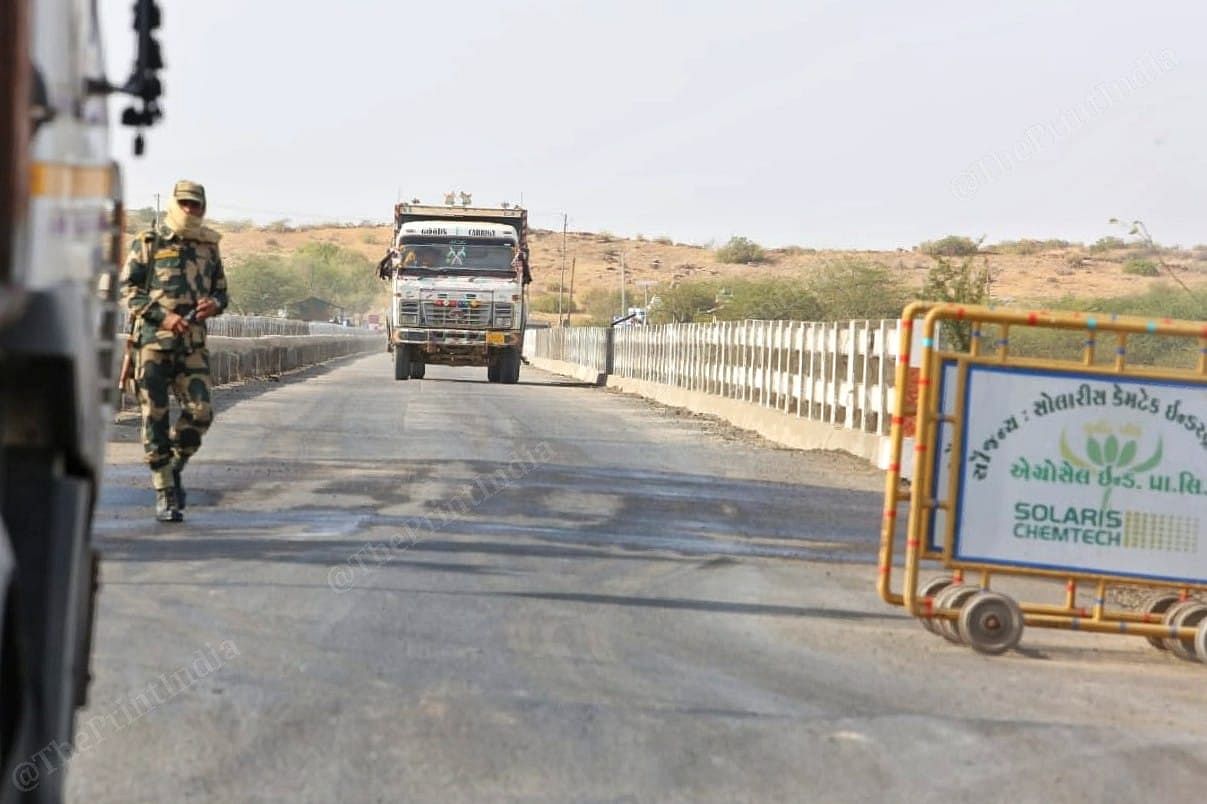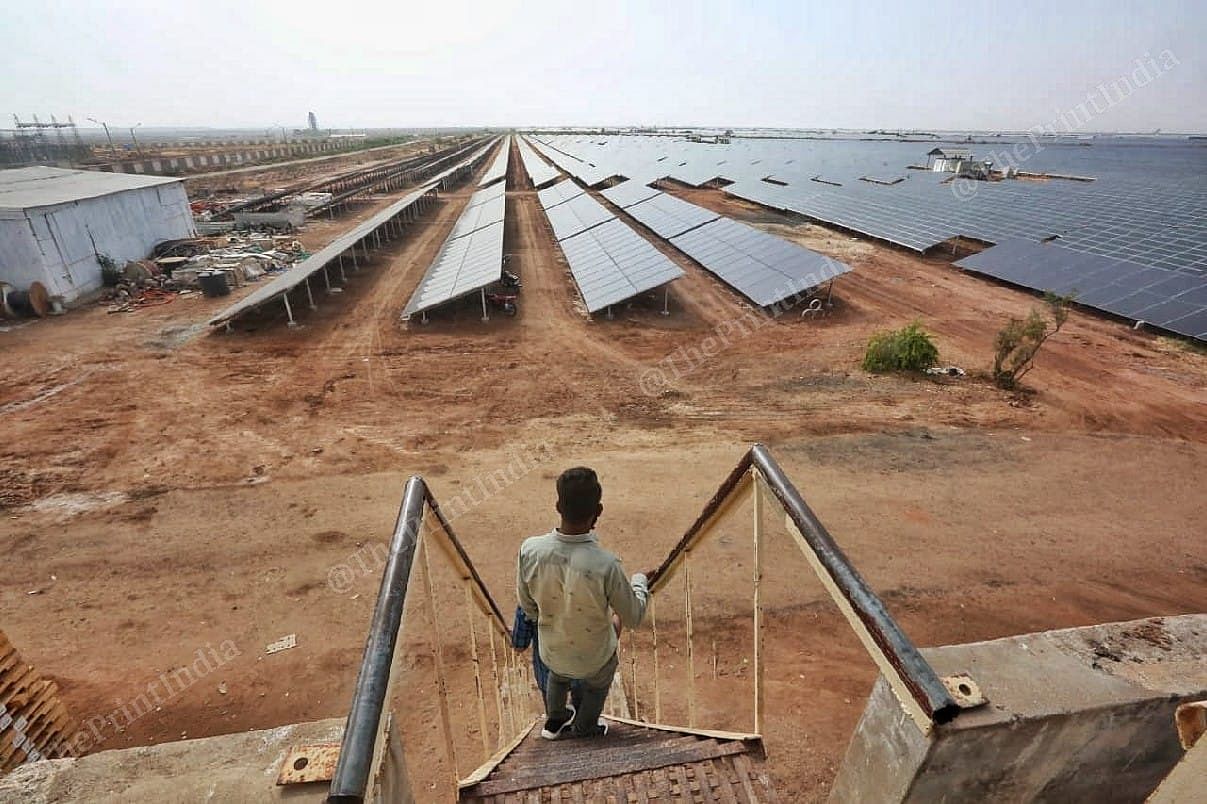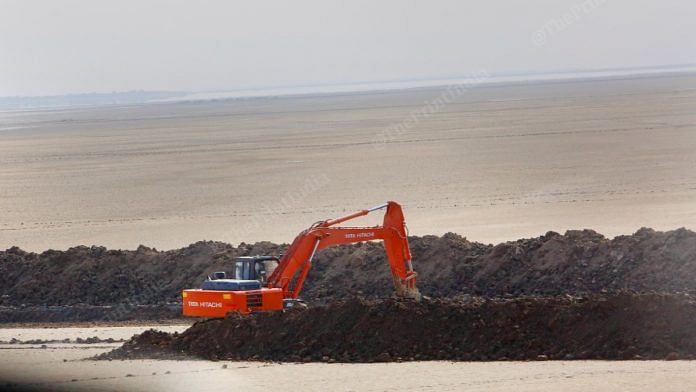India Bridge, Kutch: Approximately 30 kilometres from the last point accessible to civilians in the Rann of Kutch, an area roughly the size of Singapore — 72,600 hectares or 726 square kilometres — has been set aside for what is being touted as the world’s largest hybrid solar-wind power park.
In this remote desert area, where no human resides, the sun beats down relentlessly and temperatures soar to 35 degrees Celsius during the day. Gusts of wind flow uninterrupted across the bare landscape, making it ideal for the kind of set-up the government has in mind.
In December 2020, Prime Minister Narendra Modi laid the foundation stone for the project, which is expected to produce 30 gigawatts (GW), or 30,000 megawatts (MW) of power. The park, he said, will involve an investment of Rs 1.5 lakh crore.
Four months since, a road leading to the site of the project from the India Bridge in Kutch is under construction, expected to be completed by December this year. If all goes according to plan, the park will be able to generate 15 GW of energy by 2024.
Rajendra Mistry, chief project officer with the state-run Gujarat Power Corporation Limited, which is overseeing the park’s development, said its construction will begin once the road is completed. “The power from this park will be sent both within Gujarat and outside, to other states,” he added.
The park is expected to catalyse India’s shift from coal-based power amid a global effort to mitigate climate change. As of November 2020, India’s renewable energy capacity stood at 90.39 GW, with a target of 175 GW by 2022.
In 2014, the Union government launched the Development of Solar Parks and Ultra Mega Solar Power Projects scheme, aiming to open 50 solar parks and ultra mega solar power projects, with a capacity of at least 500 MW each. In 2017, the total target for the project was increased to 40,000 MW from 25,000 MW.
The Gujarat government has been a key player in the race to increase solar power generation. In December 2020, the government announced a new policy lifting restrictions on the capacity for solar power generation as part of its target of producing 30,000 MW by 2022.
The Kutch solar and wind power park could help the state achieve its goal in one fell swoop.
Also Read: Why it’s always sunny in India’s renewable power market
Gujarat’s solar ambitions
Last year, Gujarat was reported to be the top state in domestic solar panel installations, accounting for 68 per cent of the country’s 79,950 fittings. It currently ranks fifth in the country in terms of solar power capacity — after Karnataka, Telangana, Rajasthan, and Andhra Pradesh.
Sunaina Tomar, Additional Chief Secretary, Power, said Gujarat first introduced a solar power generation policy in 2009.
“Gujarat is a forward-looking and progressive state that decided way back in 2009, by notifying a state-specific solar policy, to contribute in a big way for mitigating the adverse impact of climate change, ensuring sustainable development by producing green and clean energy, and, thereafter, in achieving the national target of 175 GW by 2022 and 450 GW by 2030 set by Hon’ble Prime Minister of India,” she wrote to ThePrint over WhatsApp.
“Solar power is more predictable and produced in day time, which suits the huge power requirement of agriculture.”
The Kutch solar project will replace the 2,000 MW solar park in Pavagada, Karnataka, as the “world’s largest”. The Pavagada plant, which opened in 2018, supplies over 19 per cent of the country’s solar power, and had an installed capacity of 27,199 MW at the end of 2018.
According to a March 2020 report, Gujarat received the highest share of central financial assistance for its renewable energy projects in 2019-20. It is counted among the few states that have the potential to host the kind of park coming up in Kutch.
“Gujarat and Rajasthan are among the few states that have abundant wastelands. States like Maharashtra and Andhra Pradesh can’t afford to open up such large land areas for solar parks,” said Disha Agrawal, Programme Lead for Renewables at the Council on Energy, Environment, and Water (CEEW), a Delhi-based think tank. “There is scope for investments, jobs are created, plus they can generate power and sell it outside and earn revenue.”
The cost of generating solar electricity is as low as Rs 3 per unit, said Mistry. This is lower than coal-generated power, which costs between Rs 3.5 and Rs 4 per unit. Integrating solar power with the existing electricity grid is what causes the cost to rise, but this hasn’t deterred investors from getting involved in the sector.
“Investors have to produce power and supply to grid. Integration costs are to be taken care of by transmission and distribution companies. Since the cost of solar power is very low, it is still viable even with slightly higher integration cost,” said Tomar.
“The financial position of Gujarat discoms is sound and making payment to generators on time, hence investors have a lot of enthusiasm in putting up their solar plants in Gujarat,” she added.
Six players chosen
To illustrate the extent of the electricity the park will supply, Mistry said, “One megawatt is roughly between 4,000 and 5,000 units of power. On average, the Indian household consumes 5 units of power per day. This plant, when finished, will supply 30,000 megawatts of power.”
Six developers have been engaged to develop the park and generate electricity, five of which will produce energy through both wind and solar sources.
Each megawatt of energy takes up two hectares of land. Accordingly, the state government has allotted 19,000 hectares to Adani Green Energy Limited, 9,500 hectares each to Sarjan Realities and the state-run National Thermal Power Corporation (NTPC), 6,650 hectares to the state-owned Gujarat State Electricity Corporation, and 4,750 hectares to Gujarat Industries Power Company Limited, also a state government company.
The sixth — the central government’s Solar Energy Corporation of India (SECI) — will take up 23,000 hectares to produce 11,500 megawatts of solar power.
“The developers were chosen after they made applications that were screened to see if they met our pre-requisite criteria,” Mistry said. “They will be responsible for the development of basic infrastructure, connectivity, drainage system et cetera. They will also be the ones to generate the power.”
The project site, which lies between the Border Security Force-manned India Bridge and the India-Pakistan border, is still under the control of the Army, which granted permission for the park in 2020. Even today, construction work for the site can only be done with a special permit from the BSF.

During the inauguration, Modi said the solar power park would “secure the border”. A BSF officer stationed at India Bridge, who did not wish to be named, said it will require greater vigilance on their part. “Right now we have to guard one road (the bridge). Soon there will be three here, so it will require more vigilance,” the officer added.
Also Read: Solar power on saffron field: How ‘first-of-a-kind’ project in J&K will produce electricity
Concerns about development
The solar park in Kutch was inspired by the country’s first solar park 290 kilometres away, in Charanka village. The solar park in Charanka started off with a target of 215 MW but has grown to generate over 600 MW through 32 developers.
In 2012, when Charanka was first inaugurated, Modi, who was then chief minister, said it would “usher in a new revolution in this area”, and create jobs for local residents, besides promising to build a Sun Temple and lake to attract tourists.

But a visit to the village adjacent to the solar park shows these promises haven’t been fulfilled. Local roads haven’t been developed either.
“Only a handful of people from the village work in the park, as security guards. When Modi inaugurated the park, we were promised development and free electricity. But we don’t have a hospital, or a decent school. It’s been over 10 years,” said Bupat Singh, who lives next to the solar park.
Several villagers, including sarpanch Sumesh Singh Rana, said they haven’t benefited as expected from the park, for which over 200 acres of land was purchased.
“I used to grow jeera on 16 acres of land, but since I sold the land, I earn a living working on other people’s farms. We don’t have jobs, as was promised to us,” said Diba Haza, a Dalit farmer from Charnka village.
In a paper published in the peer-reviewed Journal of Peasant Studies in 2019, Ryan Stock, assistant professor at Northern Michigan University, and Trevor Birkenholtz, associate professor at Penn State, cited a survey among 200 Charanka residents to conclude that only 63 people (31.5 per cent) were ever employed at the solar park, “which included short-term construction work at the founding of the project”.
Of those whose land was acquired, “only 39.3 per cent were offered employment at the solar park”.
“…The state often claims that these agrarian transformations will lead to a ‘rural resurgence’. In reality, these land transformations alter relations of production, which may ultimately undermine the vitality of Indian peasant agriculture due to a coercive redistribution of land,” it added.
“As the Government of India develops more solar parks in the drylands to profitably mitigate climate change and generate much-needed renewable energy, marginalized populations should not be left in the dark,” it said.
The effects of solar power parks on surrounding communities hasn’t been adequately studied, said Agrawal of the CEEW.
“Because the enthusiasm to set up solar power parks has been a relatively recent phenomenon, we’re only just starting to look at the effects they have on people’s livelihoods. It’s definitely something that should looked at as we chase high targets,” she said.
In Kutch, where water is a scarce resource, villagers who live closest to the park — about 35 kilometers away from the site — are apprehensive about the promises made.
The PM had announced that a desalination plant would supply “10 crore litres of clean water” to 8 lakh people living in the region.
“We got water last week after one month. We normally arrange for water through a private supplier, paying Rs 700 for 4,000 litres of water,” said Sama Mushta Ibrahim, who lives in Motagaon and earns his living rearing goats.
His friend and neighbour Gani Jacob added: “We don’t know when this desalination plant will come up, it could take years. And who’s to say it will benefit us? We don’t even have taps in every household.”
Tomar, however, denied local communities aren’t adequately benefitted by the projects. “They are getting jobs there during construction of solar projects and, after, for maintenance of the same. Of course, the number of jobs is less in solar projects considering the huge area occupied as compared to coal-based projects but surrounding communities are certainly benefited in getting jobs without causing any displacement, pollution or adverse environmental affects.”
(Edited by Sunanda Ranjan)
Also Read: Adani-Total deal a sign — foreign investors see India’s market potential for green energy



